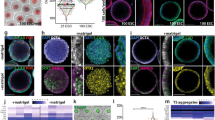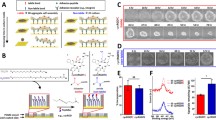Abstract
Cell–cell interaction is an integral part of embryoid body (EB) formation controlling 3D aggregation. Manipulation of embryonic stem (ES) cell interactions could provide control over EB formation. Studies have shown a direct relationship between EB formation and ES cell differentiation. We have previously described a cell surface modification and cross-linking method for influencing cell–cell interaction and formation of multicellular constructs. Here we show further characterisation of this engineered aggregation. We demonstrate that engineering accelerates ES cell aggregation, forming larger, denser and more stable EBs than control samples, with no significant decrease in constituent ES cell viability. However, extended culture ≥5 days reveals significant core necrosis creating a layered EB structure. Accelerated aggregation through engineering circumvents this problem as EB formation time is reduced. We conclude that the proposed engineering method influences initial ES cell-ES cell interactions and EB formation. This methodology could be employed to further our understanding of intrinsic EB properties and their effect on ES cell differentiation.





Similar content being viewed by others
References
Abilez O, Benharash P, Mehrotra M, Miyamoto E, Gale A, Picquet J, Xu C, Zarins C (2006) A novel culture system shows that stem cells can be grown in 3D and under physiologic pulsatile conditions for tissue engineering of vascular grafts. J Surg Res 132:170–178
Bauwens C, Yin T, Dang SM, Peerani R, Zandstra PW (2005) Development of a perfusion fed bioreactor for embryonic stem cell-derived cardiomyocyte generation: oxygen-mediated enhancement of cardiomyocyte output. Biotechnol Bioeng 90:452–461
Bauwens CL, Peerani R, Niebruegge S, Woodhouse KA, Kumacheva E, Husain M, Zandstra PW (2008) Control of human embryonic stem cell colony and aggregate size heterogeneity influences differentiation trajectories. Stem Cells 26:2300–2310
Bielby RC, Boccaccini AR, Polak JM, Buttery LDK (2004) In vitro differentiation and in vivo mineralization of osteogenic cells derived from human embryonic stem cells. Tissue Eng 10:1518–1528
Bratt-Leal AM, Carpenedo RL, McDevitt TC (2009) Engineering the embryoid body microenvironment to direct embryonic stem cell differentiation. Biotechnol Prog 25:43–51
Burridge PW, Anderson D, Priddle H, Munoz MDB, Chamberlain S, Allegrucci C, Young LE, Denning C (2007) Improved human embryonic stem cell embryoid body homogeneity and cardiomyocyte differentiation from a novel V-96 plate aggregation system highlights interline variability. Stem Cells 25:929–938
Buttery LDK, Bourne S, Xynos JD, Wood H, Hughes FJ, Hughes SPF, Episkopou V, Polak JM (2001) Differentiation of osteoblasts and in vitro bone formation from murine embryonic stem cells. Tissue Eng 7:89–99
Carpenedo RL, Sargent CY, McDevitt TC (2007) Rotary suspension culture enhances the efficiency, yield, and homogeneity of embryoid body differentiation. Stem Cells 25:2224–2234
Carpenedo RL, Bratt-Leal AM, Marklein RA, Seaman SA, Bowen NJ, McDonald JF, McDevitt TC (2009) Homogeneous and organized differentiation within embryoid bodies induced by microsphere-mediated delivery of small molecules. Biomaterials 30:2507–2515
Choi D, Lee HJ, Jee S, Jin S, Koo SK, Paik SS, Jung SC, Hwang SY, Lee KS, Oh B (2005) In vitro differentiation of mouse embryonic stem cells: enrichment of endodermal cells in the embryoid body. Stem Cells 23:817–827
Come J, Nissan X, Aubry L, Tournois J, Girard M, Perrier AL, Peschanski M, Cailleret M (2008) Improvement of culture conditions of human embryoid bodies using a controlled perfused and dialyzed bioreactor system. Tissue Eng C 14:289–298
De Bank PA, Kellam B, Kendall DA, Shakesheff KM (2003) Surface engineering of living myoblasts via selective periodate oxidation. Biotechnol Bioeng 81:800–808
De Bank PA, Hou Q, Warner RM, Wood IV, Ali BE, MacNeil S, Kendall DA, Kellam B, Shakesheff KM, Buttery LDK (2007) Accelerated formation of multicellular 3-D structures by cell-to-cell cross-linking. Biotechnol Bioeng 97:1617–1625
Enmon RM Jr, O’Connor KC, Lacks DJ, Schwartz DK, Dotson RS (2001) Dynamics of spheroid self-assembly in liquid-overlay culture of DU 145 human prostate cancer cells. Biotechnol Bioeng 72:579–591
Feraud O, Cao Y, Vittet D (2001) Embryonic stem cell-derived embryoid bodies development in collagen gels recapitulates sprouting angiogenesis. Lab Invest 81:1669–1681
Fok EYL, Zandstra PW (2005) Shear-controlled single-step mouse embryonic stem cell expansion and embryoid body-based differentiation. Stem Cells 23:1333–1342
Goodwin AM (2007) In vitro assays of angiogenesis for assessment of angiogenic and anti-angiogenic agents. Microvasc Res 74:172–183
Gothard D, Roberts SJ, Shakesheff KM, Buttery LDK (2009) Engineering embryonic stem cell aggregation allows an enhanced osteogenic differentiation in vitro. Tissue Eng C. doi:10.1089/ten.TEC.2009.0462
Hanjaya-Putra D, Gerecht S (2009) Vascular engineering using human embryonic stem cells. Biotechnol Prog 25:2–9
Itskovitz-Eldor J, Schuldiner M, Karsenti D, Eden A, Yanuka O, Amit M, Soreq H, Benvenisty N (2000) Differentiation of human embryonic stem cells into embryoid bodies compromising the three embryonic germ layers. Mol Med 6:88–95
Jiang Y, Pjesivac-Grbovic J, Cantrell C, Freyer JP (2005) A multiscale model for avascular tumor growth. Biophys J 89:3884–3894
Karlsson KR, Cowley S, Martinez FO, Shaw M, Minger SL, James W (2008) Homogeneous monocytes and macrophages from human embryonic stem cells following coculture-free differentiation in M-CSF and IL-3. Exp Hematol 36:1167–1175
Kim C, Lee IH, Lee K, Ryu SS, Lee SH, Lee KJ, Lee J, Kang JY, Kim TS (2007) Multi-well chip for forming a uniform embryoid body in a tiny droplet with mouse embryonic stem cells. Biosci Biotechnol Biochem 71:2985–2991
Koike M, Sakaki S, Amano Y, Kurosawa H (2007) Characterization of embryoid bodies of mouse embryonic stem cells formed under various culture conditions and estimation of differentiation status of such bodies. J Biosci Bioeng 104:294–299
Kurosawa H (2007) Methods for inducing embryoid body formation: in vitro differentiation system of embryonic stem cells. J Biosci Bioeng 103:389–398
Lee CN, Cheng WF, Chang MC, Su YN, Chen CA, Hsieh FJ (2005) Hypoxia-induced apoptosis in endothelial cells and embryonic stem cells. Apoptosis 10:887–894
Mansergh FC, Daly CS, Hurley AL, Wride MA, Hunter SM, Evans MJ (2009) Gene expression profiles during early differentiation of mouse embryonic stem cells. BMC Dev Biol 9:5
Messana JM, Hwang NS, Coburn J, Elisseeff JH, Zhang Z (2008) Size of the embryoid body influences chondrogenesis of mouse embryonic stem cells. J Tissue Eng Regen Med 2:499–506
Moeller HC, Mian MK, Shrivastava S, Chung BG, Khademhosseini A (2008) A microwell array system for stem cell culture. Biomaterials 29:752–763
Mogi A, Ichikawa H, Matsumoto C, Hieda T, Tomotsune D, Sakaki S, Yamada S, Sasaki K (2009) The method of mouse embryoid body establishment affects structure and developmental gene expression. Tissue Cell 41:79–84
Ng ES, Davis RP, Azzola L, Stanley EG, Elefanty AG (2005) Forced aggregation of defined numbers of human embryonic stem cells into embryoid bodies fosters robust, reproducible hematopoietic differentiation. Blood 106:1601–1603
Niebruegge S, Nehring A, Baer H, Schroeder M, Zweigerdt R, Lehmann J (2008) Cardiomyocyte production in mass suspension culture: embryonic stem cells as a source for great amounts of functional cardiomyocytes. Tissue Eng A 14:1591–1602
Parekkadan B, Berdichevsky Y, Irimia D, Leeder A, Yarmush G, Toner M, Levine JB, Yarmush ML (2008) Cell-cell interaction modulates neuroectodermal specification of embryonic stem cells. Neurosci Lett 438:190–195
Robertson E, Bradley A, Kuehn M, Evans M (1986) Germ-line transmission of genes introduced into cultured pluripotential cells by retroviral vector. Nature 323:445–448
Rohani L, Karbalaie K, Vahdati A, Hatami M, Nasr-Esfahani MH, Baharvand H (2008) Embryonic stem cell sphere: a controlled method for production of mouse embryonic stem cell aggregates for differentiation. Int J Artif Organs 31:258–265
Sachlos E, Auguste DT (2008) Embryoid body morphology influences diffusive transport of inductive biochemicals: a strategy for stem cell differentiation. Biomaterials 29:4471–4480
Song H, O’Connor KC, Lacks DJ, Enmon RM, Jain SK (2003) Monte carlo simulation of LNCaP human prostate cancer cell aggregation in liquid-overlay culture. Biotechnol Prog 19:1742–1749
Ungrin MD, Joshi C, Nica A, Bauwens C, Zandstra PW (2008) Reproducible, ultra high-throughput formation of multicellular organization from single cell suspension-derived human embryonic stem cell aggregates. PLoS ONE 3:e1565
Yirme G, Amit M, Laevsky I, Osenberg S, Itskovitz-Eldor J (2008) Establishing a dynamic process for the formation, propagation, and differentiation of human embryoid bodies. Stem Cells Dev 17:1227–1241
Youn BS, Sen A, Behie LA, Girgis-Gabardo A, Hassell JA (2006) Scale-up of breast cancer stem cell aggregate cultures to suspension bioreactors. Biotechnol Prog 22:801–810
Acknowledgements
We would like to thank the Histopathology Department of the Queens Medical Centre, Nottingham for their help with EB sectioning and H&E stains. Thanks also to Dr. Daniel Howard and Dr. Magdalen Self for their advice and guidance. Thanks also to technicians Mrs Christine Grainger-Boultby and Mrs Teresa Marshall for help with equipment training. A final thanks to the BBSRC for funding the research.
Author information
Authors and Affiliations
Corresponding author
Rights and permissions
About this article
Cite this article
Gothard, D., Roberts, S.J., Shakesheff, K.M. et al. Controlled embryoid body formation via surface modification and avidin–biotin cross-linking. Cytotechnology 61, 135–144 (2009). https://doi.org/10.1007/s10616-010-9255-3
Received:
Accepted:
Published:
Issue Date:
DOI: https://doi.org/10.1007/s10616-010-9255-3




